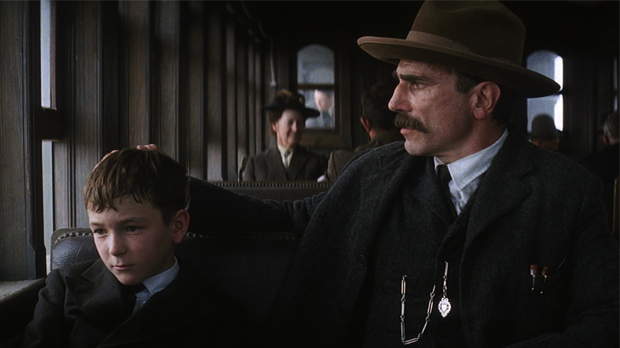 Back to selection
Back to selection
Movies Without Cuts: A Scientist’s Experiments to Expand Cinema’s Language
 There Will Be Blood
There Will Be Blood A few days ago at Pacific Standard, Jennifer Ouellette profiled Sergei Gepshtein, a neuroscientist with a dream: to eliminate cutting from movies as much as possible. Gephstein studies human perception and the window of visibility. What Gephstein’s doing is tracking how human eyes respond to basic images: the visual example you can see in the profile concerns a series of lines forming the shape of a cube. The brain has to sort out whether it’s “seeing” the cube from above or below. “Either orientation can be discerned in the original image, but the brain cannot see both at once,” Oullette notes. “It will pick one. That is an example of perceptual organization, something we all engage in without realizing it.”
Research along these lines isn’t uncommon: for example, check out this fascinating gallery from a study tracking where people’s eyes tended to land in the frame when watching There Will Be Blood. Gephstein wants to use this kind of information and apply it to direct people’s eyes more systematically: for starters, knowing where they’re going to look (or not look) can help in practical matters. “Imagine large flight information boards at airports that can display different messages to people depending on how close or far away they are from the display, or how fast or slow they are moving,” Oullette explains in a supplementary post at Scientific American. “You would see a detailed flight schedule from a short distance, for example, but those further away would see any urgent updates, sch as a flight’s imminent departure or a security alert.”
Beyond the practical, Gephstein wants to help get shot composition down to more of a science. The ability to determine what kind of visual information viewers perceive and/or tune out would help seamlessly introduce elements within a shot without the need to cut, although Gephstein’s not quite sure what this would look like. Still, he’s frustrated by what he seems to perceive as the unthinking tyranny of editing. “The film industry rests on a narrow selection of possibilities that got discovered early on and then got canonized by the force of inertia and entrenched by film-making technology and habit,” he says.
Arguing against editing certainly isn’t new: André Bazin famously argued for the virtues of sustained deep focus shots over editing. What’s new-ish is the attempt to systematize shot composition through quantifiable methods. (Experiments in single-take cinema like Russian Ark and Time Code don’t seem to be what Gephstein is interested in: they’re about duration, not perceptual manipulation per se.) There Will Be Blood draws viewers’ eyes to the same spots because of P.T. Anderson’s uncannily precise compositional sense. Will it ever be possible to give those lacking visual skills the tools to fake it? That’s not Gephstein’s goal and it seems improbable: top-notch compositions are low on most viewers’ priority lists, so resources are unlikely to be routinely directed to ensure them where they otherwise wouldn’t exist. But it’s intriguing that Gephstein’s partner in experimentation is Alex McDowall, a production designer who dubs himself a “world-builder”: could the F/X masters and craftsmen of the world ensure more dynamic compositions behind their directors’ backs?
